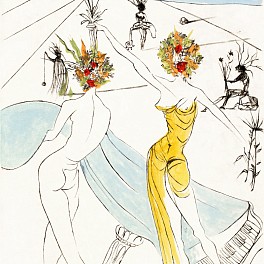BIOGRAPHY

1904 - 1989
Salvador Dalí was many things to many people: painter, etcher, sculptor, magician, aspiring alchemist. His parents regarded him as the reincarnation of his deceased older brother Salvador, and they made Dalí his namesake. Living in his brother’s shadow from his birth, the younger Salvador Dalí formed a unique point of view of the world. Visual references to his ever-present, ever-absent brother, the passive figure of a slender man casting a long shadow, appear in many of Dalí’s works.
In 1929 he was formally invited to join the Surrealist group in Paris. After meeting Surrealist poet Paul Eluard and his wife Gala, he fell in love with the poet’s wife and ran away with her. The following year Dalí and Gala settled at Port Lligat, Spain.
In 1934 at the age of 30 Dalí exhibited a group of drawings and engravings inspired by the Comte de Lautréament’s Chants de Maldoror, and he first met Pierre Argillet, a photographer and publisher who would encourage him to publish his visual interpretations of many more auspicious literary works. Argillet himself published Dalí’s etchings and drypoints from 1960 to 1972. Some 40 years later, after their formal business relationship was over, Argillet helped his old friend by purchasing the plates for the engravings that first attracted him to Dalí’s work.
In 1939 Dalí was formally expelled from the Surrealists because he refused to support their political agenda. The expulsion was not really because of the purity of Dalí’s artistic motives, but more because his statements, such as, I am Surrealism, grated on his colleagues, and his ego could no longer be contained within the group.
In 1940 the Dalís fled France shortly before the Nazi invasion. Picasso paid for their passage from Lisbon to the US where they lived for eight years in Virginia, Pebble Beach, California and New York City, respectively. In the US, Dalí made initial contact with some of his greatest patrons, and he collaborated with Walt Disney on Destino (finally released in the spring of 2004) and with Alfred Hitchcock on the dream sequence in Spellbound.
Upon their return to Europe in 1949, the Dalís continued to live together for two additional decades, but in 1969 Gala moved to Pubol Castle, and Dalí was allowed to visit her by invitation only. After Gala’s death in 1982, his muse was gone, and although he continued to go through the motions of producing work until about 1987, the ingenious master had outlived even his old man style. In 1989 Dalí died of heart failure in his beloved Figueres, Spain.
